Imagination and Invention Click on the thumbnails to explore the trail
Read more about this trail (expand)
The exercise of imaginative fantasy was as much an integral part of Leonardo’s mind as the discipline of scientific observation. For the artist, imagination was dependent upon an accurate understanding of observational input – a complete comprehension of the geometry of God’s design. Sensory impressions gained from observation were recombined by the artist’s ‘fantasia’ or imagination, to create new and credible forms

- Enlarge
-
Fol 175r - Ideas for new drums © Permission by British Library 263
Codex Arundel 1490s–c1518
Leonardo’s ability as a musician and his involvement in courtly entertainments must have helped to generate ideas for the invention of new musical instruments. On this sheet, he applies mechanical theory to design a whole range of instruments, including eleven types of drums.
In the column on the right, there are five drums that provide workable solutions for changing pitch during a performance. Such drums were not invented until the 19th century. The third from the top is a kettle-drum, which is tightened with cords that go to a disc attached to a screw and crank. The drum is on a stand so that the crank might be turned manually while the drum is being played. By turning the crank, the tension of all the cords might be altered simultaneously, rather than individually which was traditionally the case. The fourth is “flute drum” with holes in its cylindrical body that might be covered to vary the pitch.
There are also drums designed to produce simultaneous tones or chords in one compound instrument, such as the side drum with a snare and cones inserted into its base.
In Leonardo's words
Music cannot be called otherwise than the sister of painting, for she is dependent upon hearing, a sense of second sight, and her harmony is composed of the union of its proportional parts sounded simultaneously, rising and falling in one or more harmonic rhythms.
Leonardo described part of this manuscript as “a collection of notes without order, composed of many pages which I have copied, hoping then to put them in their appropriate place, according to the topics that they treat”.
The sheets of this manuscript deal with a variety of mainly technical and mechanical subjects, such as weights and geometry, as well as architectural studies related to the residence of Francis I at Romarantin, France. The manuscript also contains an ingenious design for a device for breathing under water.
The Codex Arundel is a bound manuscript containing 238 pages of various sizes that have been gleaned from other manuscripts.
- Medium Pen and ink on paper
- Size 21 x 15 cm
- Location British Library










